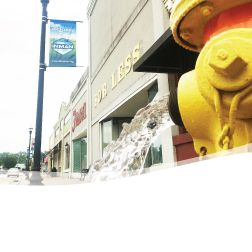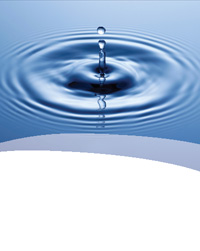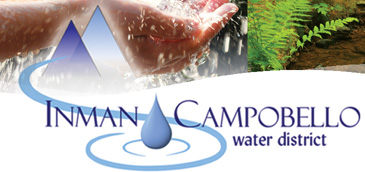Water is essential to life. Without it, the biosphere that exists on the
surface of the earth wouldn't be possible. Nicknamed the "water" planet,
Earth is covered by one of our most precious resources. However, almost
93% is lock ed
in the oceans, toxic to humans and many plants and animals. ed
in the oceans, toxic to humans and many plants and animals.
How do we obtain fresh water resources then?
Where does drinkable water come from? To understand, we need to turn to
the Hydrologic Cycle.
Water's molecular arrangement is very
simple, two hydrogens to each oxygen atoms, but this is misleading. Water
has many unique properties that allow it to be such a universal material.
One special characteristic of water is its ability to change state very
easily under Earth conditions. It can be found readily on the planet in
all of its three forms, solid, liquid, and gas. These forms also play a
great part in the hydrologic cycle. Now, exactly what is the hydrologic
cycle.? The hydrologic cycle takes place in the hydrosphere,
this is the region containing all the water in the atmosphere and on the
surface of the earth. The cycle is the movement of water through this
hydrosphere.
Now the entire process is very simple,
divided in to five parts
- Condensation
- Infiltration
- Runoff
- Evaporation
- Precipitation
The process begins with
condensation, when water vapor condenses in the atmosphere to
form clouds. Condensation occurs when
the temperature of the air or earth changes. Water changes states when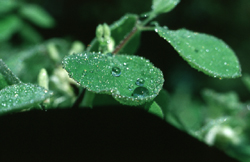 temperatures fluctuate. So when the air cools enough, water vapor has to
condense on particles in the air to form clouds. This process is very
noticeable on plants as they dew in the morning.
temperatures fluctuate. So when the air cools enough, water vapor has to
condense on particles in the air to form clouds. This process is very
noticeable on plants as they dew in the morning.
As clouds form, winds move them across the globe, spreading out the water
vapor. When eventually the clouds can't hold the moisture, they release it
in the form of precipitation, which can be snow, rain, hail, etc.
The next three stages: infiltration, runoff, and evaporation occur
simultaneously. Infiltration occurs when precipitation
seeps into the ground. This depends a lot on the permeability of the
ground.
Permeability is the measure of how easily something flows through a
substance. The more permeable, the more precipitation seeps into the
ground. If precipitation occurs faster than it can infiltrate the ground,
it becomes runoff. Runoff remains on the surface and
flows into streams, rivers, and eventually large bodies such as lakes or
the ocean. Infiltrated groundwater moves similarly as it recharges rivers
and heads towards large bodies of water.
As both of these processes are happening, the power of the sun is driving
this cycle by causing evaporation. Evaporation is the
change of liquid water to a vapor. Sunlight aids this process as it raises
the temperature of liquid water in oceans and lakes.
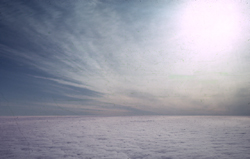 As
the liquid heats, molecule are released and change into a gas. Warm air
rises up into the atmosphere and becomes the vapor involved in
condensation. As
the liquid heats, molecule are released and change into a gas. Warm air
rises up into the atmosphere and becomes the vapor involved in
condensation.
Considering so little of the water on
earth is drinkable to people, it is amazing the supply has survived as
long as it has. The hydrologic cycle continues to move water and keep
sources fresh. It is estimated that 100 million billion gallons a year are
cycled through this process. Without this process life on Earth would be
impossible. We need it to sustain us and for all of our life processes to
function. Without water, life would not be possible on Earth.
[ BACK ] |


